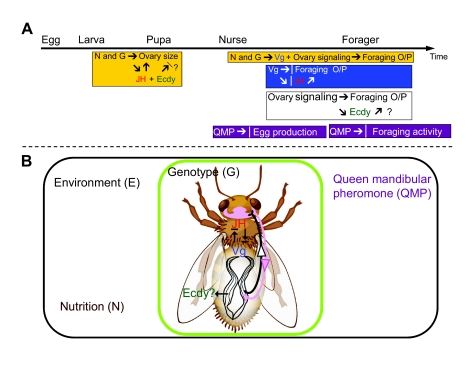Fig. 5.
Model to explain roles of ovaries in a regulatory network of social behavior. Ovary size is determined by nutrition (N) status and colony genotype (G) at the last larval stage, which is affected by a systemic hormone, JH (Bloch et al., 2000; Schmidt-Capella and Hartfelder, 1998). Results from the present study and those from Wang et al. suggest that ecdysteroids (Ecdy) may be involved in apoptosis for shaping ovary size (Wang et al., 2009). Queen mandibular pheromone (QMP) inhibits egg production in nurses and slows workers to forage in their later lives. Nutrition and genotype also play important roles in regulating ovary signaling and vitellogenin (Vg) titers in adult workers, which affect age of foraging onset (O) and foraging preference (P). Vg regulates foraging O/P directly or through a feedback loop with JH (Amdam et al., 2004; Amdam and Omholt, 2003; Ihle et al., 2010). Worker ovaries can accelerate foraging O/P, in which ecdysteroids may function. There are also neural regulations between the ovary and brain, which may be involved in these behavioral networks.

